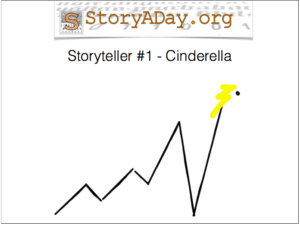Three unexpected people were in the headlines last year: Adele, Gwen Stefani, and Seinfeld. Each of them achieved phenomenal success in different ways and for different reasons. But as I followed their stories, I realized that they had a common denominator—one key ingredient to their success—and it’s something every writer needs.
Their Stories
1. Adele
In 2015, Adele finally released her album 25 after four long years—a hiatus no one, including Adele, had expected. The album came out at the end of the year, but it still easily swept away its competition, selling eight million copies in six weeks in the US alone. (To put that number in perspective, Taylor Swift released her album 1989 the previous year and it sold 3.66 million copies in eight weeks, less than half of Adele’s sales.)
2. Gwen Stefani
I doubt anyone expected Gwen Stefani to be on the Billboard charts in 2016—she hadn’t had a solo album or even a hit single in over a decade. True, in 2014 she was a coach on “The Voice,” but her appearance didn’t even ruffle the music industry.
Then in 2015, Gwen rocketed into the headlines, but not for the reason she would have liked. After thirteen years of marriage, she divorced Gavin Rossdale, the lead singer of Bush. Somehow, despite the tsunami of scrutiny and gossip, Gwen was on stage at the Grammys only seven months later, live-filming her new hit song “Make Me Love You” (in Rollerblades, no less).
3. Seinfeld
In 2015, Hulu paid more than $150 million for the rights to air “Seinfeld”—that’s over $80,000 per episode for a twenty-year-old TV show. Jerry Seinfeld called it a “mind-blowing moment.”
The Common Denominator
Seinfeld: “It Was Fun to Do”
When Jerry announced Hulu’s multi-million-dollar deal, he reminisced not on the show’s success, but on its initial failure. The first four years, he said, were dismal: “people were not catching on to it,” it was “barely scraping by,” and it had “very low ratings.” Jerry recalled saying to a friend, “I don’t get it. This show seems funny to me.”
Then “Seinfeld” got an unexpected boost when it was moved to Thursday nights, airing right after the popular “Cheers.” All of the sudden it took off. But Jerry’s point was that, for half of the show’s life, “it didn’t seem to be working,” yet he and the rest of the crew kept at it simply because “it was fun to do.” “We were really doing it for ourselves for a long, long time.”
Gwen Stefani: “The Most Non-commercial, Personal Record Ever”
After her divorce, Gwen was distraught, embarrassed, and “down all the way.” But she refused to let it define her. She told herself, “I have to turn this into something. I can’t go down like this.” Music was her answer. She walked into the studio and said, “I don’t care about the charts, the hits, the style of music, I just want to tell the truth.”
Gwen wrote and recorded song after song—she felt empowered and confident—but when she sent her record company a demo, she was told that her songs were “too personal, too artistic,” people wouldn’t relate to them. Gwen called it a “punch in the face.”
Still, she walked back into the studio the next day and said, “Let’s write the most non-commercial, personal record ever.” The result was “Used to Love You,” which became the first single off her first solo album in eleven years. She called the album This Is What the Truth Feels Like, and it debuted last month at number one on the Billboard albums chart.
Adele: “It’s the Real Part of Me”
The popularity of Adele is almost impossible to grasp. On the day of 25‘s release, it sold one thousand copies per minute in the US, and it became 2015’s best-selling album worldwide. But the story behind 25 is mostly one of failure and crises.
After the jaw-dropping success of her second album in 2011, Adele worried she could never top it. She even considered walking away from music: “There was quite a long period where I didn’t believe in myself when I was making [25]. I lost my confidence.”
For years Adele wandered in and out of the studio, frustrated and confused, until she realized that the songs she was writing were “great to the ear, but they didn’t move [her].” Finally, she started focusing on what was important to her: “25 is about getting to know who I’ve become without realising.” After the album’s release, Adele said, “I’ve made the realest record I can make. It’s the real part of me.”
Your Key to Success
“Seinfeld” was a failure for years. Gwen Stefani hadn’t had a hit in a decade. Adele didn’t think she could ever top her previous album. But they all found outward success by, ironically, turning inward. They ignored “commercial” and focused on personal. To them it wasn’t about, as Thornton Wilder said, impressing other people. It was about expressing themselves.
Prompt: Write the Real You
The scariest part about creating art (real art) is that it demands exposure. The human instinct is to protect—after all, that’s how we’ve survived for thousands of years. More often than not, we become afraid and drag down our real art until it’s only a pale, flabby imitation. But not today.
Today you write the story you’ve been too afraid to write—the story that is too personal, too boring, too weird, too serious, too comical, too embarrassing. You write the story that you think everyone will judge and no one will understand. You write the story that interests you, inspires you, fulfills you, and you write it with confidence.
 C. S. Plocher is a freelance editor with an award-winning blog. Her job is to help people chase their dreams, and she loves it.
C. S. Plocher is a freelance editor with an award-winning blog. Her job is to help people chase their dreams, and she loves it.







